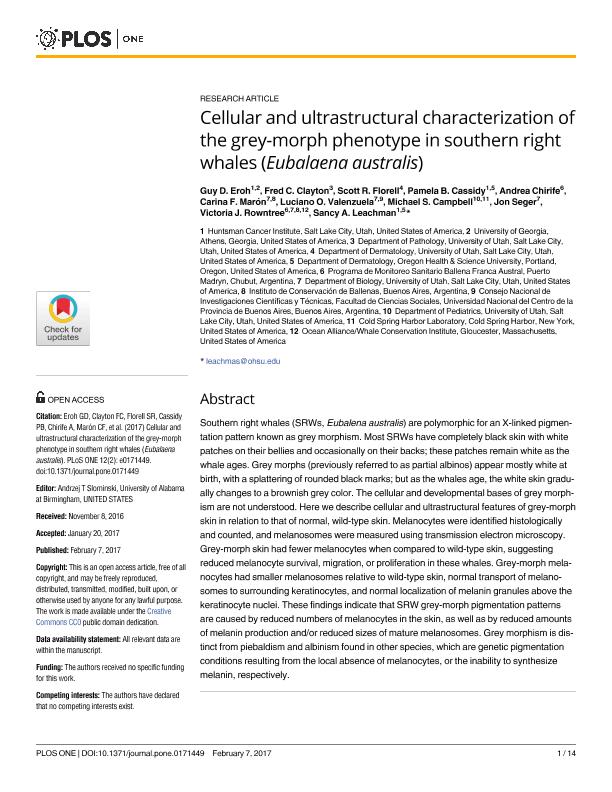Mostrar el registro sencillo del ítem
dc.contributor.author
Eroh, Guy D.
dc.contributor.author
Clayton, Fred C.
dc.contributor.author
Florell, Scott R.
dc.contributor.author
Cassidy, Pamela B.
dc.contributor.author
Chirife, Andrea
dc.contributor.author
Marón, Carina Flavia

dc.contributor.author
Valenzuela, Luciano Oscar

dc.contributor.author
Campbell, Michael S.
dc.contributor.author
Seger, Jon
dc.contributor.author
Rowntree, Victoria J.
dc.contributor.author
Leachman, Sancy A.
dc.date.available
2018-09-10T15:57:51Z
dc.date.issued
2017-02
dc.identifier.citation
Eroh, Guy D.; Clayton, Fred C.; Florell, Scott R.; Cassidy, Pamela B.; Chirife, Andrea; et al.; Cellular and ultrastructural characterization of the grey-morph phenotype in southern right whales (Eubalaena australis); Public Library of Science; Plos One; 12; 2; 2-2017; 1-14; e0171449
dc.identifier.uri
http://hdl.handle.net/11336/58874
dc.description.abstract
Southern right whales (SRWs, Eubalena australis) are polymorphic for an X-linked pigmentation pattern known as grey morphism. Most SRWs have completely black skin with white patches on their bellies and occasionally on their backs; these patches remain white as the whale ages. Grey morphs (previously referred to as partial albinos) appear mostly white at birth, with a splattering of rounded black marks; but as the whales age, the white skin gradually changes to a brownish grey color. The cellular and developmental bases of grey morphism are not understood. Here we describe cellular and ultrastructural features of grey-morph skin in relation to that of normal, wild-type skin. Melanocytes were identified histologically and counted, and melanosomes were measured using transmission electron microscopy. Grey-morph skin had fewer melanocytes when compared to wild-type skin, suggesting reduced melanocyte survival, migration, or proliferation in these whales. Grey-morph melanocytes had smaller melanosomes relative to wild-type skin, normal transport of melanosomes to surrounding keratinocytes, and normal localization of melanin granules above the keratinocyte nuclei. These findings indicate that SRW grey-morph pigmentation patterns are caused by reduced numbers of melanocytes in the skin, as well as by reduced amounts of melanin production and/or reduced sizes of mature melanosomes. Grey morphism is distinct from piebaldism and albinism found in other species, which are genetic pigmentation conditions resulting from the local absence of melanocytes, or the inability to synthesize melanin, respectively.This is an open access article, free of all copyright, and may be freely reproduced, distributed, transmitted, modified, built upon, or otherwise used by anyone for any lawful purpose. The work is made available under the Creative Commons CC0 public domain dedication.
dc.format
application/pdf
dc.language.iso
eng
dc.publisher
Public Library of Science

dc.rights
info:eu-repo/semantics/openAccess
dc.rights.uri
https://creativecommons.org/licenses/by-nc-sa/2.5/ar/
dc.subject
.
dc.subject.classification
Otras Ciencias Biológicas

dc.subject.classification
Ciencias Biológicas

dc.subject.classification
CIENCIAS NATURALES Y EXACTAS

dc.title
Cellular and ultrastructural characterization of the grey-morph phenotype in southern right whales (Eubalaena australis)
dc.type
info:eu-repo/semantics/article
dc.type
info:ar-repo/semantics/artículo
dc.type
info:eu-repo/semantics/publishedVersion
dc.date.updated
2018-09-10T13:11:47Z
dc.identifier.eissn
1932-6203
dc.journal.volume
12
dc.journal.number
2
dc.journal.pagination
1-14; e0171449
dc.journal.pais
Estados Unidos

dc.journal.ciudad
San Francisco
dc.description.fil
Fil: Eroh, Guy D.. Huntsman Cancer Institute; Estados Unidos. University of Georgia; Estados Unidos
dc.description.fil
Fil: Clayton, Fred C.. University of Utah; Estados Unidos
dc.description.fil
Fil: Florell, Scott R.. University of Utah; Estados Unidos
dc.description.fil
Fil: Cassidy, Pamela B.. Huntsman Cancer Institute; Estados Unidos. Oregon Health & Science University; Estados Unidos
dc.description.fil
Fil: Chirife, Andrea. Instituto de Conservación de Ballenas. Programa de Monitoreo Sanitario de la Ballena Franca Austral; Argentina
dc.description.fil
Fil: Marón, Carina Flavia. University of Utah; Estados Unidos. Instituto de Conservación de Ballenas; Argentina. Consejo Nacional de Investigaciones Científicas y Técnicas; Argentina
dc.description.fil
Fil: Valenzuela, Luciano Oscar. University of Utah; Estados Unidos. Universidad Nacional del Centro de la Provincia de Buenos Aires. Facultad de Ciencias Sociales; Argentina. Consejo Nacional de Investigaciones Científicas y Técnicas; Argentina
dc.description.fil
Fil: Campbell, Michael S.. University of Utah; Estados Unidos. Cold Spring Harbor Laboratory; Estados Unidos
dc.description.fil
Fil: Seger, Jon. University of Utah; Estados Unidos
dc.description.fil
Fil: Rowntree, Victoria J.. University of Utah; Estados Unidos. Instituto de Conservación de Ballenas. Programa de Monitoreo Sanitario de la Ballena Franca Austral; Argentina. Ocean Alliance; Estados Unidos
dc.description.fil
Fil: Leachman, Sancy A.. Oregon Health & Science University; Estados Unidos. Huntsman Cancer Institute; Estados Unidos
dc.journal.title
Plos One

dc.relation.alternativeid
info:eu-repo/semantics/altIdentifier/doi/http://dx.doi.org/10.1371/journal.pone.0171449
dc.relation.alternativeid
info:eu-repo/semantics/altIdentifier/url/https://journals.plos.org/plosone/article?id=10.1371/journal.pone.0171449
Archivos asociados
